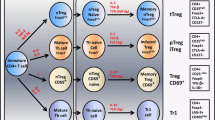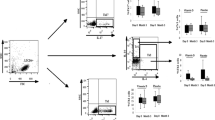Abstract
Hashimoto thyroiditis (HT) is a prototypic organ-specific autoimmune thyroid disease, for which the exact etiology remains unclear. The aim of this study was to investigate dynamic changes in regulatory T cell (Treg) and T helper 17 cell (Th17) populations in patients with HT at different stages of thyroid dysfunction, as well as to analyze the possible correlation between the Treg/Th17 cell axis and autoimmune status in HT. We assessed thyroid function and autoantibody serology both in HT patients and in healthy controls (HCs) and divided HT patients into three subgroups according to thyroid function. We then determined the percentages of Treg and Th17 cells in peripheral blood mononuclear cells and analyzed mRNA expression of the Treg and Th17 cell-defining transcription factors Foxp3 and RORγt. In addition, serum levels of TGF-β and IL-17A were assessed. We found that the percentage of Treg cells, Foxp3 mRNA levels, and the ratio of Treg/Th17 cells were all significantly lower in HT patients, while Th17 cell percentages and RORγt mRNA levels were significantly higher. Interestingly, we also observed significant differences in these measurements between HT patient subgroups. Serum IL-17A levels were markedly increased in HT patients, while serum concentrations of TGF-β were lower, compared to HCs. The ratio of Treg/Th17 cells was negatively correlated with the levels of serum thyroperoxidase antibody, thyroglobulin antibody, and thyrotropin (TSH) in HT patients. Taken together, our data suggest that the balance between Treg and Th17 cells shifts in favor of Th17 cells during clinical progression of HT, which is negatively correlated with levels of thyroid-specific autoantibodies and TSH, implying that Treg/Th17 cell imbalance may contribute to thyroid damage in HT.




Similar content being viewed by others
References
S.H. Golden, K.A. Robinson, I. Saldanha et al., Clinical review: prevalence and incidence of endocrine and metabolic disorders in the United States: a comprehensive review. J. Clin. Endocrinol. Metab. 94(6), 1853–1878 (2009)
M. Rizzo, R.T. Rossi, O. Bonaffini et al., Increased annual frequency of Hashimoto’s thyroiditis between years 1988 and 2007 at a cytological unit of Sicily. Ann. Endocrinol. (Paris) 71(6), 525–534 (2010)
B. Delemer, J.P. Aubert, P. Nys et al., An observational study of the initial 3212 management of hypothyroidism in France: the ORCHIDEE study. Eur. J. Endocrinol. 167(6), 817–823 (2012)
M.P. Vanderpump, The epidemiology of thyroid disease. Br. Med. Bull. 99(1), 39–51 (2011)
E.N. Pearce, A.P. Farwell, L.E. Braverman, Thyroiditis. N. Engl. J. Med. 348(26), 2646–2655 (2003)
D.S. McLeod, D.S. Cooper, The incidence and prevalence of thyroid autoimmunity. Endocrine 42(2), 252–265 (2012)
S. Yu, G.C. Sharp, H. Braley-Mullen, Thyrocytes responding to IFN-gamma are essential for development of lymphocytic spontaneous autoimmune thyroiditis and inhibition of thyrocyte hyperplasia. J. Immunol. 176(2), 1259–1265 (2006)
S. Koida, K. Tsukasaki, T. Tsuchiya et al., Primary T-cell lymphoma of the thyroid gland with chemokine receptors of Th1 phenotype complicating autoimmune thyroiditis. Haematologica 92(3), e37–40 (2007)
H. Qiu, W. Tang, P. Yin et al., Cytotoxic T-lymphocyte associated antigen 4 polymorphism and Hashimoto’s thyroiditis susceptibility: a meta-analysis. Endocrine 45(2), 198–205 (2014)
M. Feng, F.B. Zhang, H.R. Deng, The CTLA4 +49A/G polymorphism is associated with an increased risk of Hashimoto’s thyroiditis in Asian but not Caucasian populations: an updated meta-analysis. Endocrine 44(2), 350–358 (2013)
S. Alfadhli, Q. Almutawa, J.M. Abbas et al., Association of Hashimoto’s thyroiditis with cytotoxic T lymphocyte-associated antigen-4 (CTLA-4) and inducible co-stimulator (ICOS) genes in a Kuwaiti population. Endocrine 43(3), 666–677 (2013)
J. Yang, Q. Qin, N. Yan et al., CD40 C/T(-1) and CTLA-4 A/G(49) SNPs are associated with autoimmune thyroid diseases in the Chinese population. Endocrine 41(1), 111–115 (2012)
S. Sakaguchi, M. Ono, R. Setoguchi et al., Foxp3+CD25+CD4+ natural regulatory T cells in dominant self-tolerance and autoimmune disease. Immunol. Rev. 212, 8–27 (2006)
Q. Tang, J.A. Bluestone, The Foxp3+ regulatory T cell: a jack of all trades, master of regulation. Nat. Immunol. 9(3), 239–244 (2008)
J. Zhu, W.E. Paul, CD4 T cells: fates, functions, and faults. Blood 112(5), 1557–1569 (2008)
A.B. Glick, A. Wodzinski, P. Fu, A.D. Levine, D.N. Wald, Impairment of regulatory T-cell function in autoimmune thyroid disease. Thyroid 23(7), 871–878 (2013)
C.T. Weaver, R.D. Hatton, P.R. Mangan, L.E. Harrington, IL-17 family cytokines and the expanding diversity of effector T cell lineages. Annu. Rev. Immunol. 25, 821–852 (2007)
E. Bettelli, M. Oukka, V.K. Kuchroo, T(H)-17 cells in the circle of immunity and autoimmunity. Nat. Immunol. 8(4), 345–350 (2007)
J. Furuzawa-Carballeda, M.I. Vargas-Rojas, A.R. Cabral, Autoimmune inflammation from the Th17 perspective. Autoimmun. Rev. 6(3), 169–175 (2007)
P. Miossec, T. Korn, V.K. Kuchroo, Interleukin-17 and type 17 helper T cells. N. Engl. J. Med. 361(9), 888–898 (2009)
T. Korn, E. Bettelli, M. Oukka, V.K. Kuchroo, IL-17 and Th17 Cells. Annu. Rev. Immunol. 27, 485–517 (2009)
Y. Shi, H. Wang, Z. Su et al., Differentiation imbalance of Th1/Th17 in peripheral blood mononuclear cells might contribute to pathogenesis of Hashimoto’s thyroiditis. Scand. J. Immunol. 72(3), 250–255 (2010)
J.T. Dunn, H.E. Crutchfield, R. Gutekunst, A.D. Dunn, Methods for measuring iodine in urine (International Council for the Control of Deficiency Disorders, Wageningen, 1993)
W. Teng, Z. Shan, X. Teng et al., Effect of iodine intake on thyroid diseases in China. N. Engl. J. Med. 354(26), 2783–2793 (2006)
I. Raphael, S. Nalawade, T.N. Eagar, T.G. Forsthuber, T cell subsets and their signature cytokines in autoimmune and inflammatory diseases. Cytokine (2014). doi:10.1016/j.cyto.2014.09.011
N. Figueroa-Vega, M. Alfonso-Perez, I. Benedicto et al., Increased circulating pro-inflammatory cytokines and Th17 lymphocytes in Hashimoto’s thyroiditis. J. Clin. Endocrinol. Metab. 95(2), 953–962 (2010)
D. Peng, B. Xu, Y. Wang, H. Guo, Y. Jiang, A high frequency of circulating Th22 and Th17 cells in patients with new onset Graves’ disease. PLoS ONE 8(7), e68446 (2013)
G.P. Morris, N.K. Brown, Y.C. Kong, Naturally-existing CD4+CD25+Foxp3+ regulatory T cells are required for tolerance to experimental autoimmune thyroiditis induced by either exogenous or endogenous autoantigen. J. Autoimmun. 33(1), 68–76 (2009)
S. Yu, P.K. Maiti, M. Dyson et al., B cell-deficient NOD.H-2h4 mice have CD4+CD25+T regulatory cells that inhibit the development of spontaneous autoimmune thyroiditis. J. Exp. Med. 203(2), 349–358 (2006)
J.D. Fontenot, J.P. Rasmussen, L.M. Williams et al., Regulatory T cell lineage specification by the forkhead transcription factor Foxp3. Immunity 22(3), 329–341 (2005)
J.C. Marie, J.J. Letterio, M. Gavin, A.Y. Rudensky, TGF-beta l maintains suppressor function and Foxp3 expression in CD4+CD25+ regulatory T cells. J. Exp. Med. 201(7), 1061–1067 (2005)
D. Li, W. Cai, R. Gu et al., Th17 cell plays a role in the pathogenesis of Hashimoto’s thyroiditis in patients. Clin. Immunol. 149(3), 411–420 (2013)
M. Klatka, E. Grywalska, M. Partyka et al., Th17 and Treg cells in adolescents with Graves’ disease. Impact of treatment with methimazole on these cell subsets. Autoimmunity 47(3), 201–211 (2014)
B. Kristensen, L. Hegedüs, H.O. Madsen et al., Altered balance between self-reactive Th17 cells and Th10 cells and between full-length Foxp3 and Foxp3 splice variants in Hashimoto’s thyroiditis. Clin. Exp. Immunol. (2014). doi:10.1111/cei.12557
H.G. Evans, T. Suddason, I. Jackson et al., Optimal induction of T helper 17 cells in humans requires T cell receptor ligation in the context of Toll-like receptor-activated monocytes. Proc. Natl. Acad. Sci. USA 104(43), 17034–17039 (2007)
E.V. Acosta-Rodriguez, G. Napolitani, A. Lanzavecchia, F. Sallusto, Interleukins 1beta and 6 but not transforming growth factor-beta are essential for the differentiation of interleukin 17-producing human T helper cells. Nat. Immunol. 8(9), 942–949 (2007)
N.J. Wilson, K. Boniface, J.R. Chan et al., Development, cytokine profile and function of human interleukin 17-producing helper T cells. Nat. Immunol. 8(9), 950–957 (2007)
L. Zhou, J.E. Lopes, M.M. Chong et al., TGF-beta-induced Foxp3 inhibits T(H)17 cell differentiation by antagonizing RORgammat function. Nature 453(7192), 236–240 (2008)
K. Ichiyama, H. Yoshida, Y. Wakabayashi et al., Foxp3 inhibits ROR gammat-mediated IL-17 mRNA transcription through direct interaction with ROR gammat. J. Biol. Chem. 283(25), 17003–17008 (2008)
L. Shi, M. Bi, R. Yang et al., Defective expression of regulatory B cells in iodine-induced autoimmune thyroiditis in non-obese diabetic H-2(h4) mice. J. Endocrinol. Invest. 37(1), 43–50 (2014)
P.I. Spuls, L. Hooft, Brodalumab and ixekizumab, anti-interleukin-17-receptor antibodies for psoriasis: a critical appraisal. Br. J. Dermatol. 167(4), 710–713 (2012); discussion 714–715
W. Hueber, D.D. Patel, T. Dryja et al., Effects of AIN457, a fully human antibody to interleukin-17A, on psoriasis, rheumatoid arthritis, and uveitis. Sci. Transl. Med. (2010). doi:10.1126/scitranslmed.3001107
Acknowledgments
We gratefully acknowledge Dr. Bradley N. Martin (Department of Immunology, Lerner Research Institute, Cleveland Clinic Foundation, USA) for his excellent English-language-editing of the manuscript. This work was funded by the Shandong Province Higher Educational Science and Technology Program of China (No. J11LF66), Shandong Province Natural Science Foundation of China (No. ZR2013HM049), and Shandong Province Science and Technology Development Project of China (No. 2011YD18063).
Conflict of interest
The authors of this study have no conflict of interest regarding this article.
Author information
Authors and Affiliations
Corresponding author
Additional information
Haibo Xue, Xiurong Yu and Lei Ma have contributed equally to this work.
Rights and permissions
About this article
Cite this article
Xue, H., Yu, X., Ma, L. et al. The possible role of CD4+CD25highFoxp3+/CD4+IL-17A+ cell imbalance in the autoimmunity of patients with Hashimoto thyroiditis. Endocrine 50, 665–673 (2015). https://doi.org/10.1007/s12020-015-0569-y
Received:
Accepted:
Published:
Issue Date:
DOI: https://doi.org/10.1007/s12020-015-0569-y




